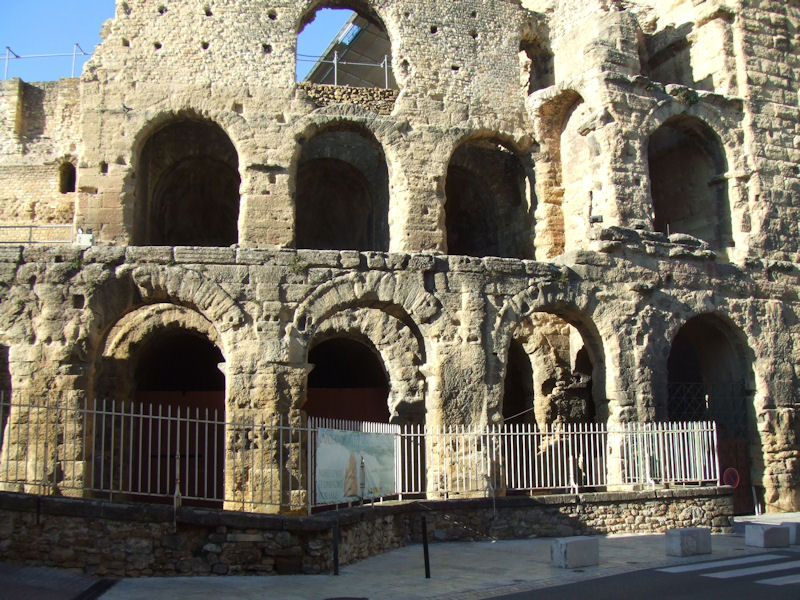You may not find this terribly rewarding unless you're included here, so this is a good time for
casual and random browsers to turn back before they get too caught
up in the sweep and majesty of the proceedings and can't let go.
We've just been ten days
marching about beautiful Corsica,
stunned by the scenery and gagged by the entrecôte, and
now we've got to go home.
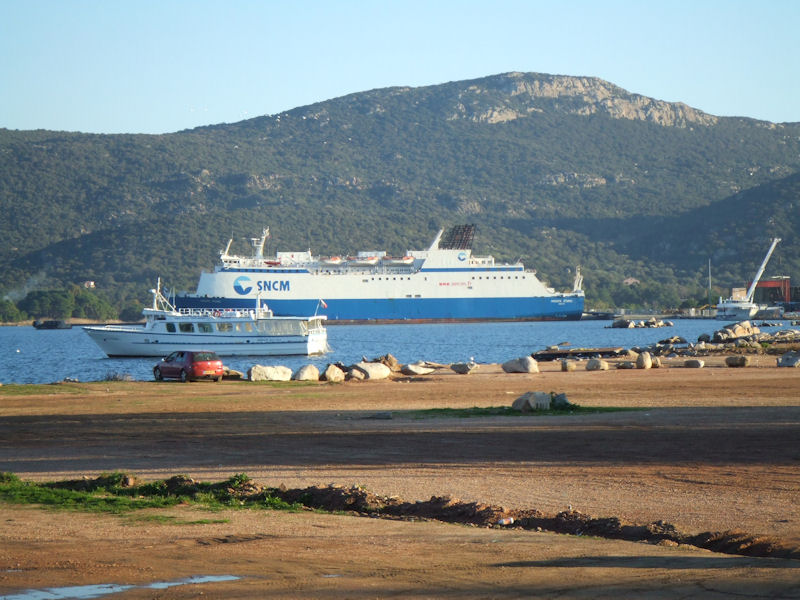
Here we are in Porto Vecchio, Corsica, ready
to take the night ferry (SNCM lines, worth recommending) back
to Marseille, onto the docks at 8 a.m. and a whole day before
us to drive home in. Straight up the autoroute péage towards
Lyon we go, and péage it certainly is (you can drive the
autoroutes in Switzerland for a full year for much less than the
French tolls on a quick dash up the Rhône valley).
With all this glorious off-season early Sunday
leisure time at our disposal, we'll stop off in Orange! That's
got to be preferable to Montelimar, the "Nougat Capital of
the World".
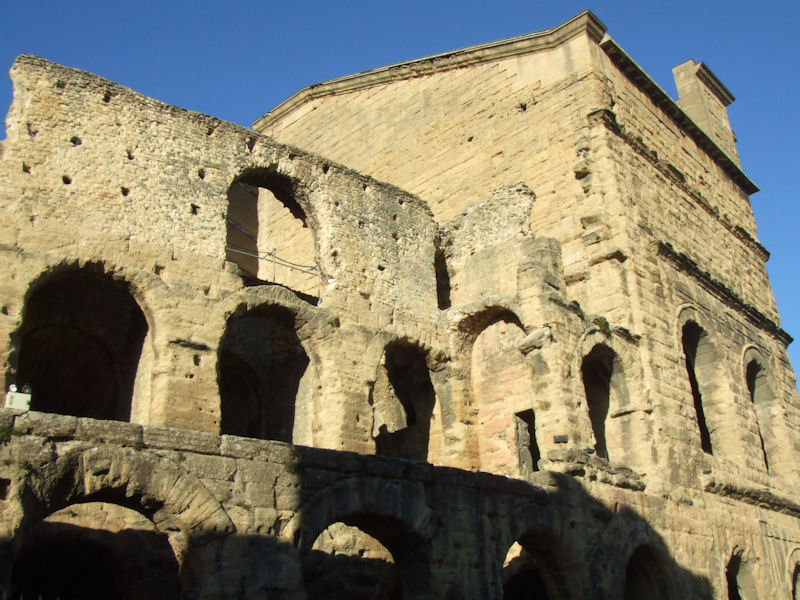
I'd only been to Orange once, and that was
in the 1970s, and all that my debilitated memory produces for
me now is a washed-out mental snapshot view of a huge Roman theatre.
As it turns out, that was fairly accurate -- the Roman Theatre
is the Thing.
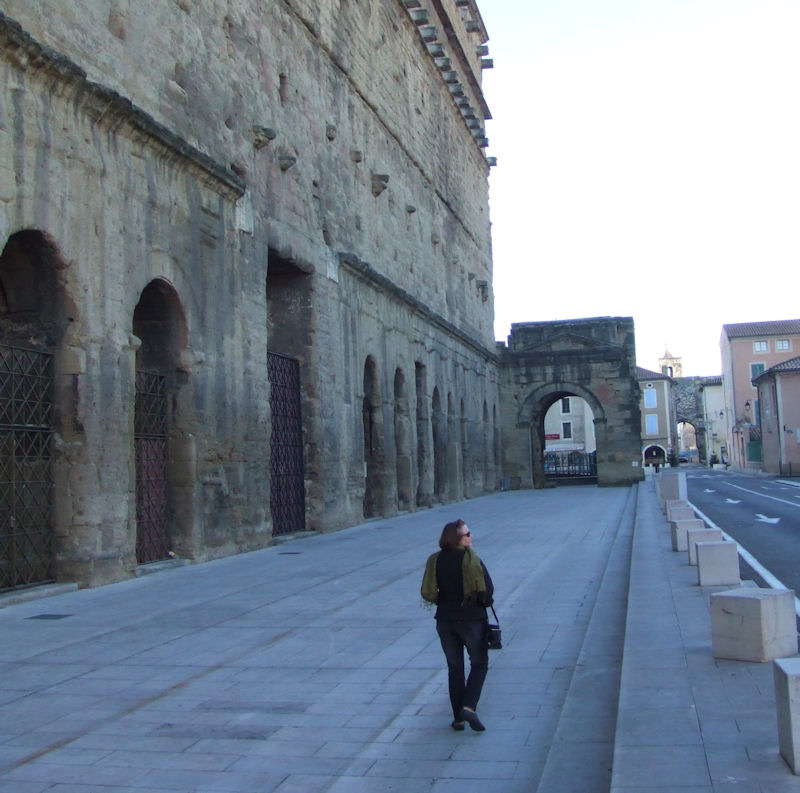
So Kristin has to see
it, too. The Theatre has been a World
Heritage cultural property since 1981 and that was extended
in 2007 to include the "triumphal arch" -- "Situated
in the Rhône valley, the ancient theatre of Orange, with
its 103m-long facade, is one of the best preserved of all the
great Roman theatres. Built between A.D. 10 and 25, the Roman
arch is one of the most beautiful and interesting surviving examples
of a provincial triumphal arch from the reign of Augustus. It
is decorated with low reliefs commemorating the establishment
of the Pax Romana."
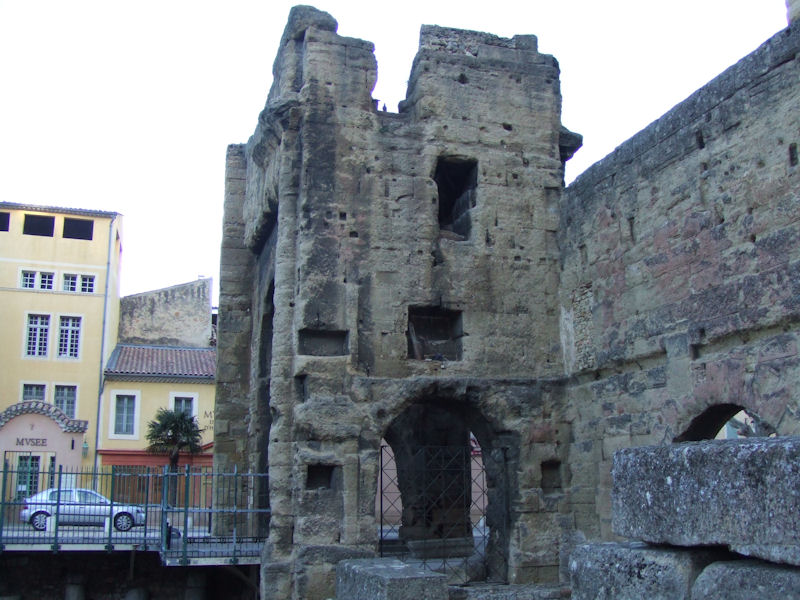
The old ticket booth looks out of use, so we
poke about a bit and discover a modern new museum and gift shop,
with extremely clean toilets, and -- with a few Euros up front
-- We're In!
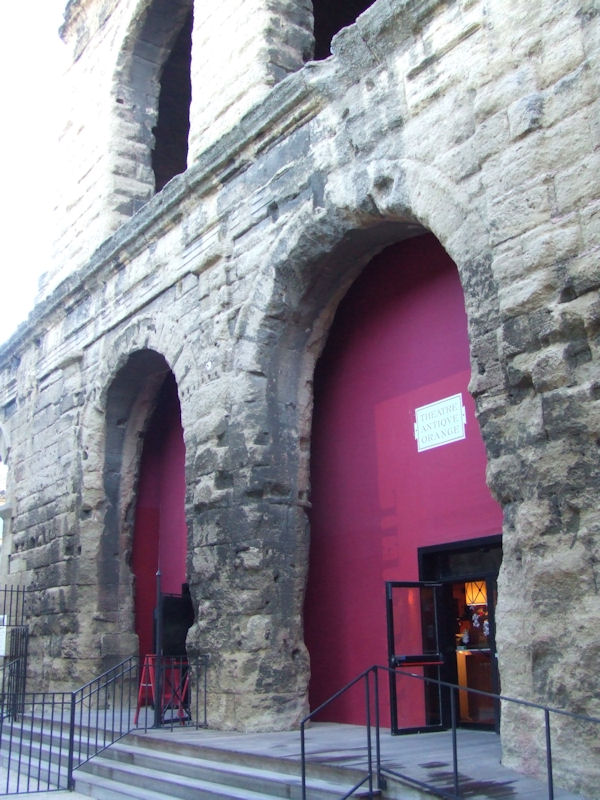
The friendly gardiennes of the site charge
you very little and hand you a wonderful walkaround audio tour
machine, suitable for hanging right round your neck to keep your
hands free for other things, whatever, that explains what you're
seeing in light-scholarly lectures at about 25 points around the
premises, with even longer supplemental segments branched off
the basic tour on such interesting subjects as "Roman theatre",
"early medieval social class structure", and so on,
in case you've got a few days to spend in there with no family
to call you in as missing or dead.
On "Roman drama", those of us who've
had to teach courses in Plautus, Terence, and Seneca will just
fastforward to the part where classical Roman drama gave way,
over time, to rambunctious free-for-alls with clowns brandishing
enormous fake penises, a devolution somewhat like Playhouse
90 to Seinfeld on American television. (That's
not entirely fair -- classical drama grew OUT OF the montrous
penis era, and then, years later, back INTO it.)
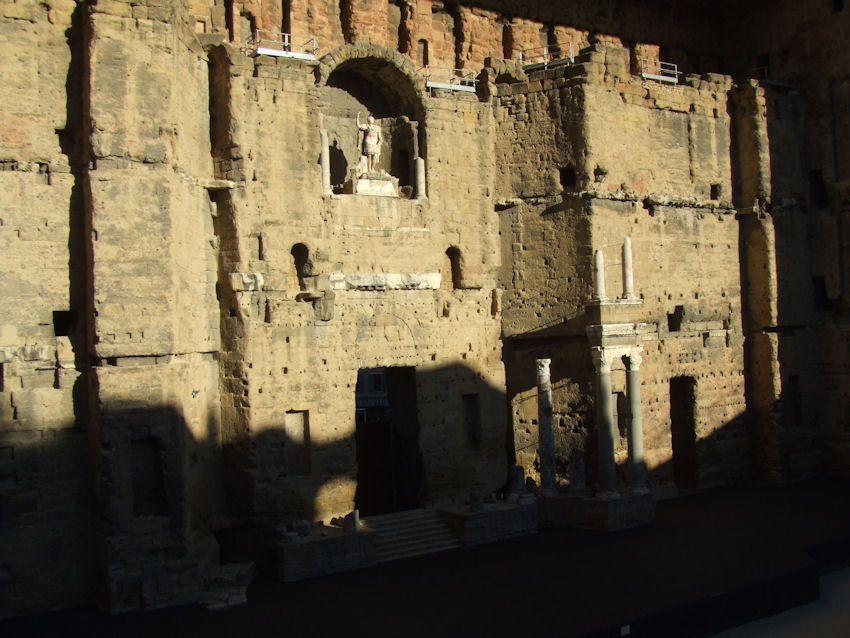
Roman theatres abound all over much of Europe,
but the back stage walls do not -- they've all fallen down, broadly
speaking, and been scavenged for schools, churches, dance halls,
opium dens, etc. In fact, this is the only Roman stage wall remaining in Europe.
There's one in Turkey, and one other somewhere else (I've forgotten
where, perhaps Libya), so much of what scholars know about Roman
theatre stage walls is this. That's
Emperor Somebodius up there in his Niche of Honor.
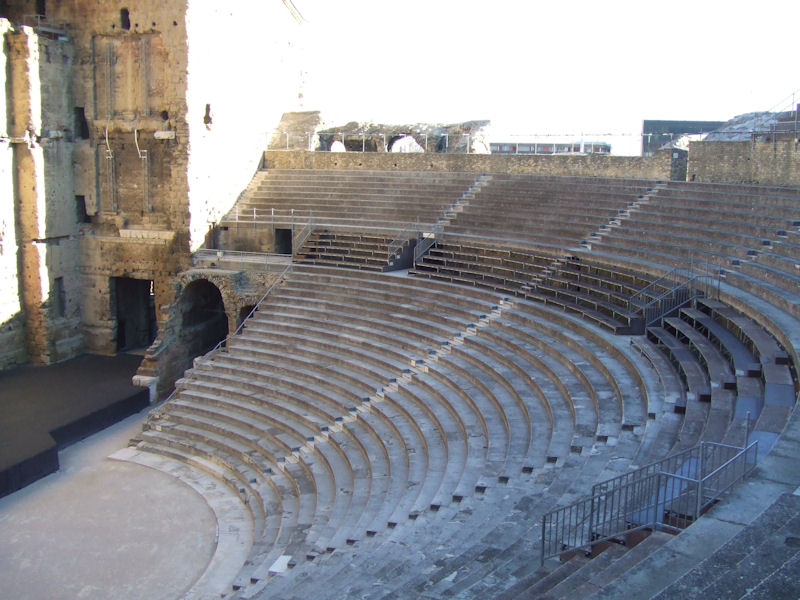
Never entirely abandoned, never entirely out
of use, the theatre in Orange with its allegedly amazing acoustics,
once dug out from under the accumulations of millennia, has for
the past century or so been the venue for a rich programme of
drama and opera.

The theatre itself, partly dug out of the St-Eutrope
hillside behind, was part of a central urban complex (forum, temples,
tearooms, fitness centres, juice bars, etc.) of Roman Arausio,
and the lot of it apparently dates more or less to about Year
Zero. In fact, that's actually meant to be Augustus Caesar there
in the Niche, gazing out as if still bestowing his benevolent
authority upon the 10,000 or so rowdies who were weeping at tragedies,
hooting at comedies, leering at the burlesque shows, and spreading
enormous picnic lunches out on the rows of seating facing him.
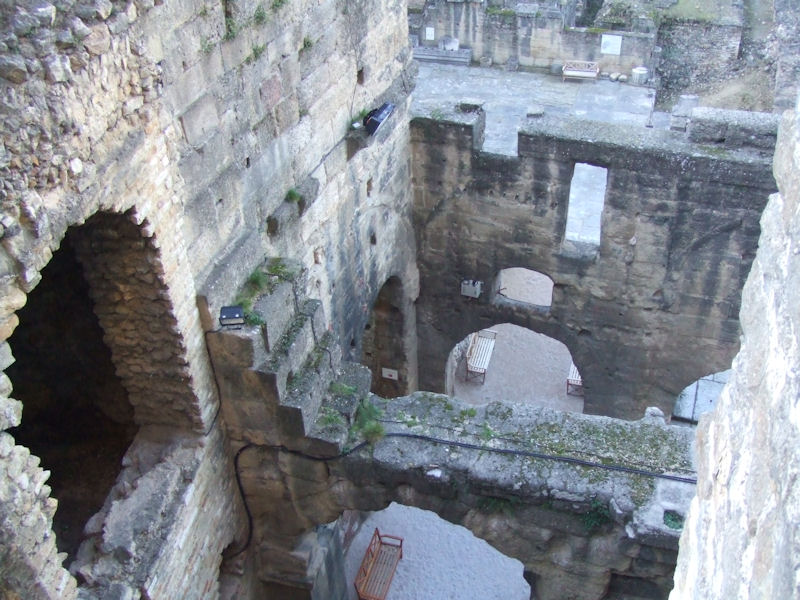
Some of the old flooring seems to be missing,
but otherwise it's astonishing how much is left. The place has
been in continuous use, not always as a theatre, of course --
as Roman provincial authority collapsed and the Alemanni and Visigoths
ravaged all about freely in the 5th century, townspeople sought
safety in the massive walls, and from early medieval times through
to the 19th century the theatre and temple had been shabbily built
up into a giant tenement building of tiny flats.
In fact, 19th century efforts to restore the
ancient heritage were frequently stalled for years by the legal
battles to get people moved out of their homes built higgledy-piggledy
in the middle of the orchestra section.

That's Kristin across the way, engrossed in
her audio guide's vivid descriptions of actors coming and going
through the side doors of the stage, civic authorities elocuting
about benevolent civic authorities and the Pax Romana, and apple-sellers
and prostitutes huffing up and down these aisles looking for customers.
We'd better call over and warn her.

"Kristin! Kristin! Just above your head!
Lots of pigeons!"

The theatre built into the hillside, presently being
painstakingly fixed up again. Kristin can be seen lost out there
in the middle of it.
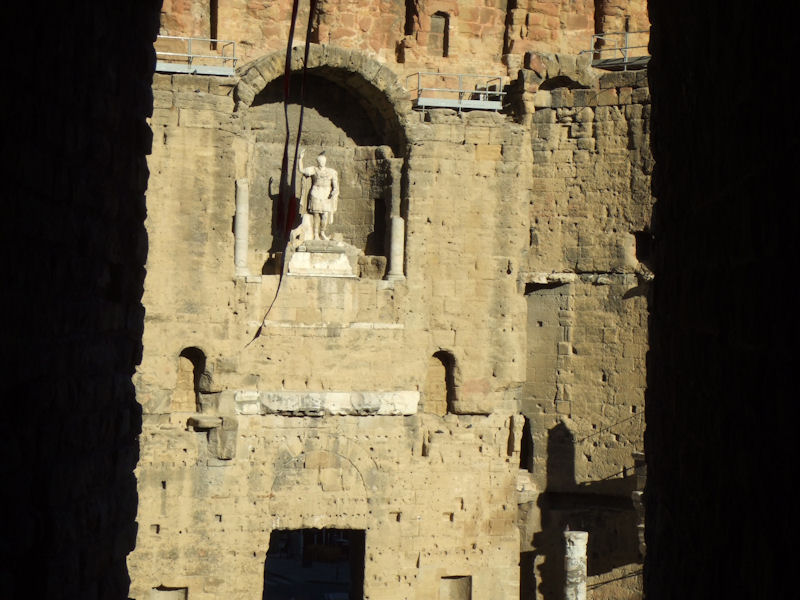
The most wonderful thing about the Emperor's
statue is that the head was modeled separately and screwed on.
As the Emperors came and went (weren't there three in A.D. 69?),
the mayor could keep within the municipal budget by purchasing
just the new head and nailing it onto the heroic warrior body.

Kristin in the Temple of Sacred Somebodia just
next door to the theatre, listening intently to her audio guide.
Charlemagne, A.D.800-ish, made Orange and its
neighborhood a official county, and the counts made themselves
princes in the 13th century, but, after a while, when Mr Philbert
of Châlons-Arley died in 1530, the title passed by the marriage
of his daughter Claudia to Hendrik III of Nassau-Breda in Germany
to her son René of Nassau. And then the city of Orange
in southern France, and its theatre and its temple and its tenement
apartments, got wired onto what eventually became, through William
"the Silent" of Orange-Nassau, first Stadtholder of
the Dutch Republic and military leader of the Dutch Revolt against
the Spanish armies until his assassination in 1584, the Royal
Family of The Netherlands. You may not find that really
strange, but I do.

This is why the Dutch footballers to this day
wear orange colors on the playing field. (Photo) Pigeon in the
Temple of Somebodia, preparing to express his religious views
upon the heads of worshippers.
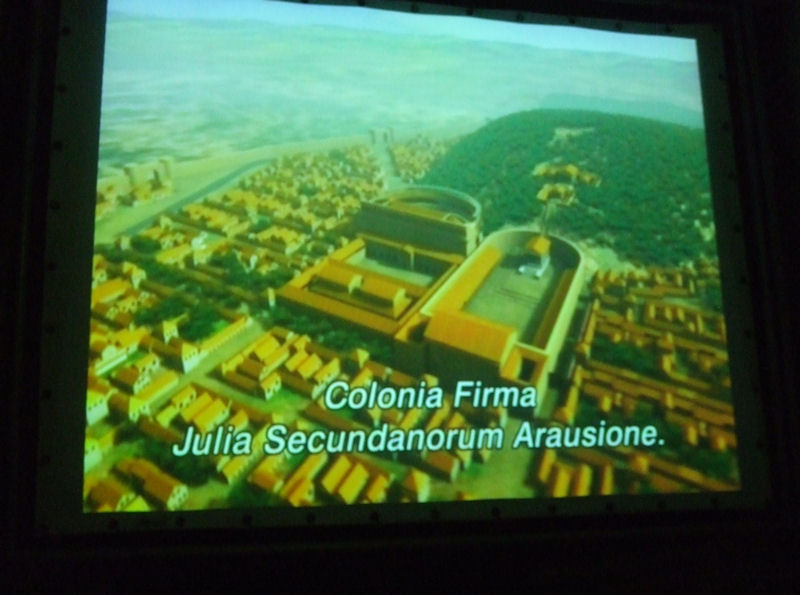
The museum in the Theatre of Orange has an excellent
media show. Included in the price of admission.

This is Frommered, Lonely-Planeted, and Blue-Guided
to be a charming downtown area, and probably it is -- we're here
early on a Sunday morning in December. Nobody looks his or her
best on a Sunday morning in December.

The façade of the Roman theatre in Orange,
and a tree-ish thing with nothing on it.

Kristin having a little lookabout in downtown
Orange, with everything closed except the boulangeries. People
can't do without their croissants.
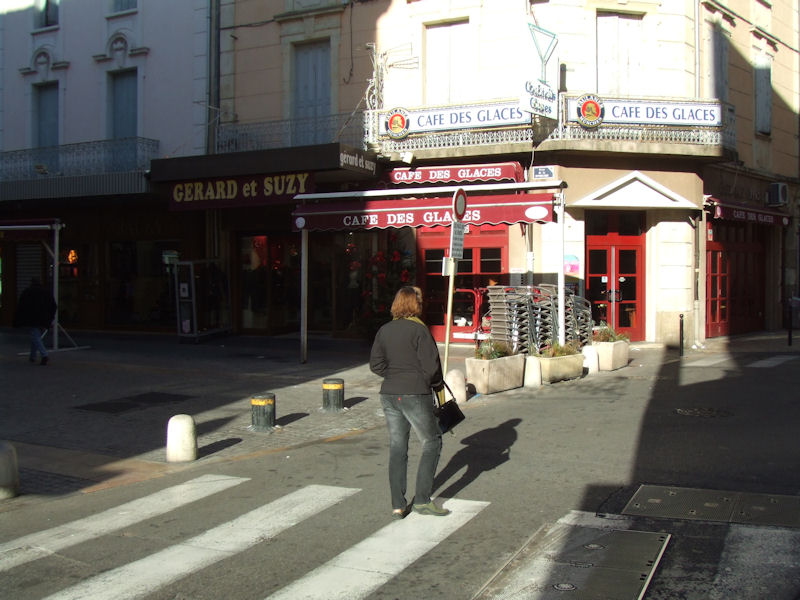
Kristin in Orange, thinking about getting back
onto the autoroute for Lyon and Geneva and home and shoveling
some of those Corsica hiking clothes into the washing machine
before they begin to rot away.
 Dwight Peck's personal website
Dwight Peck's personal website



















